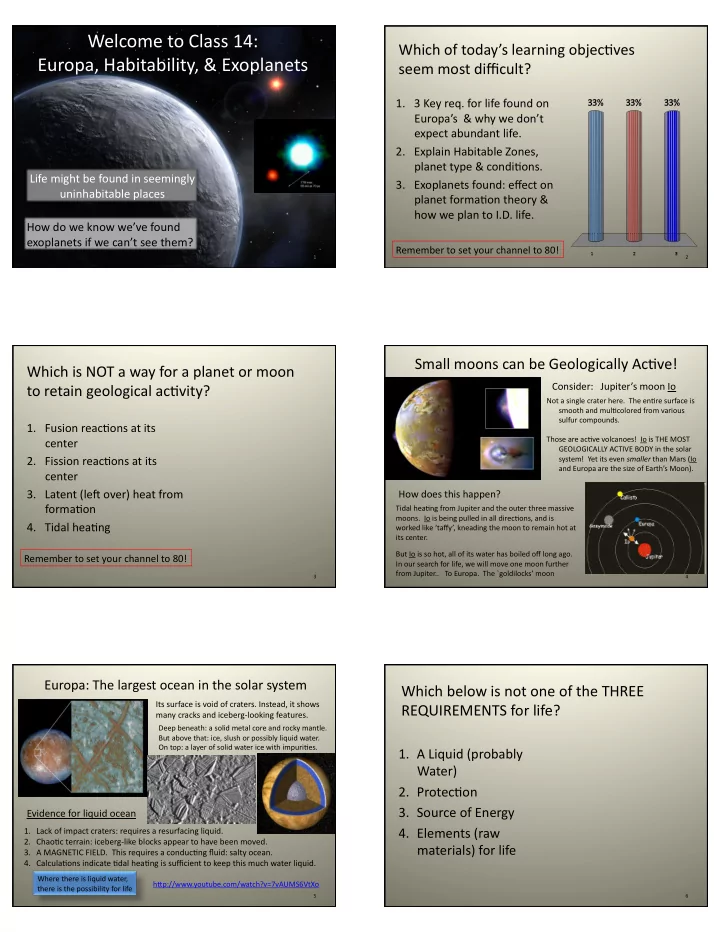

Welcome ¡to ¡Class ¡14: ¡ ¡ Which ¡of ¡today’s ¡learning ¡objecFves ¡ Europa, ¡Habitability, ¡& ¡Exoplanets ¡ seem ¡most ¡difficult? ¡ 1. 3 ¡Key ¡req. ¡for ¡life ¡found ¡on ¡ Europa’s ¡ ¡& ¡why ¡we ¡don’t ¡ expect ¡abundant ¡life. ¡ 2. Explain ¡Habitable ¡Zones, ¡ planet ¡type ¡& ¡condiFons. ¡ Life ¡might ¡be ¡found ¡in ¡seemingly ¡ 3. Exoplanets ¡found: ¡effect ¡on ¡ uninhabitable ¡places ¡ planet ¡formaFon ¡theory ¡& ¡ how ¡we ¡plan ¡to ¡I.D. ¡life. ¡ How ¡do ¡we ¡know ¡we’ve ¡found ¡ exoplanets ¡if ¡we ¡can’t ¡see ¡them? ¡ Remember ¡to ¡set ¡your ¡channel ¡to ¡80! ¡ 1 ¡ 2 ¡ Small ¡moons ¡can ¡be ¡Geologically ¡AcFve! ¡ Which ¡is ¡NOT ¡a ¡way ¡for ¡a ¡planet ¡or ¡moon ¡ Consider: ¡ ¡ ¡Jupiter’s ¡moon ¡Io ¡ ¡ to ¡retain ¡geological ¡acFvity? ¡ Not ¡a ¡single ¡crater ¡here. ¡ ¡The ¡enFre ¡surface ¡is ¡ smooth ¡and ¡mulFcolored ¡from ¡various ¡ sulfur ¡compounds. ¡ 1. Fusion ¡reacFons ¡at ¡its ¡ Those ¡are ¡acFve ¡volcanoes! ¡ ¡Io ¡is ¡THE ¡MOST ¡ center ¡ GEOLOGICALLY ¡ACTIVE ¡BODY ¡in ¡the ¡solar ¡ 2. Fission ¡reacFons ¡at ¡its ¡ system! ¡ ¡Yet ¡its ¡even ¡ smaller ¡than ¡Mars ¡(Io ¡ and ¡Europa ¡are ¡the ¡size ¡of ¡Earth’s ¡Moon). ¡ center ¡ 3. Latent ¡(leZ ¡over) ¡heat ¡from ¡ How ¡does ¡this ¡happen? ¡ formaFon ¡ Tidal ¡heaFng ¡from ¡Jupiter ¡and ¡the ¡outer ¡three ¡massive ¡ moons. ¡ ¡Io ¡is ¡being ¡pulled ¡in ¡all ¡direcFons, ¡and ¡is ¡ 4. Tidal ¡heaFng ¡ worked ¡like ¡‘taffy’, ¡kneading ¡the ¡moon ¡to ¡remain ¡hot ¡at ¡ its ¡center. ¡ But ¡Io ¡is ¡so ¡hot, ¡all ¡of ¡its ¡water ¡has ¡boiled ¡off ¡long ¡ago. ¡ ¡ ¡ Remember ¡to ¡set ¡your ¡channel ¡to ¡80! ¡ In ¡our ¡search ¡for ¡life, ¡we ¡will ¡move ¡one ¡moon ¡further ¡ from ¡Jupiter.. ¡ ¡ ¡To ¡Europa. ¡ ¡The ¡`goldilocks’ ¡moon ¡ 3 ¡ 4 ¡ Europa: ¡The ¡largest ¡ocean ¡in ¡the ¡solar ¡system ¡ Which ¡below ¡is ¡not ¡one ¡of ¡the ¡THREE ¡ Its ¡surface ¡is ¡void ¡of ¡craters. ¡Instead, ¡it ¡shows ¡ REQUIREMENTS ¡for ¡life? ¡ many ¡cracks ¡and ¡iceberg-‑looking ¡features. ¡ Deep ¡beneath: ¡a ¡solid ¡metal ¡core ¡and ¡rocky ¡mantle. ¡ ¡ But ¡above ¡that: ¡ice, ¡slush ¡or ¡possibly ¡liquid ¡water. ¡ On ¡top: ¡a ¡layer ¡of ¡solid ¡water ¡ice ¡with ¡impuriFes. ¡ 1. A ¡Liquid ¡(probably ¡ Water) ¡ 2. ProtecFon ¡ 3. Source ¡of ¡Energy ¡ Evidence ¡for ¡liquid ¡ocean ¡ 4. Elements ¡(raw ¡ 1. Lack ¡of ¡impact ¡craters: ¡requires ¡a ¡resurfacing ¡liquid. ¡ 2. ChaoFc ¡terrain: ¡iceberg-‑like ¡blocks ¡appear ¡to ¡have ¡been ¡moved. ¡ materials) ¡for ¡life ¡ 3. A ¡MAGNETIC ¡FIELD. ¡ ¡This ¡requires ¡a ¡conducFng ¡fluid: ¡salty ¡ocean. ¡ 4. CalculaFons ¡indicate ¡Fdal ¡heaFng ¡is ¡sufficient ¡to ¡keep ¡this ¡much ¡water ¡liquid. ¡ Where ¡there ¡is ¡liquid ¡water, ¡ hhp://www.youtube.com/watch?v=7vAUMS6VtXo ¡ there ¡is ¡the ¡possibility ¡for ¡life ¡ 5 ¡ 6 ¡
There ¡is ¡liquid ¡water, ¡but ¡where ¡would ¡Europan ¡life ¡ Earth, ¡the ¡Goldilocks ¡planet ¡ get ¡the ¡needed ¡elements ¡and ¡energy? ¡ Earth ¡lives ¡the ¡perfect ¡distance ¡from ¡our ¡Sun ¡for ¡liquid ¡surface ¡water ¡ The ¡ocean ¡is ¡heated ¡by ¡a ¡warm, ¡possibly ¡volcanic ¡upper ¡ mantle ¡which ¡ may ¡provide ¡ an ¡exhaust ¡of ¡chemicals ¡and ¡ If ¡our ¡Sun ¡was ¡BRIGHTER ¡Mars ¡ elements ¡needed ¡by ¡life. ¡ may ¡be ¡in ¡the ¡habitable ¡zone. ¡ ¡If ¡ our ¡Sun ¡was ¡DIMMER, ¡Venus ¡ IF ¡these ¡vents ¡occur ¡ they ¡would ¡also ¡provide ¡chemical ¡ might ¡be ¡in ¡the ¡habitable ¡zone ¡ imbalances ¡in ¡the ¡rock/water ¡boundary, ¡which ¡chemo-‑ autotrophic ¡life ¡might ¡thrive ¡around, ¡just ¡like ¡it ¡does ¡at ¡ the ¡base ¡of ¡Earth’s ¡oceans ¡around ¡black ¡smokers. ¡ As ¡a ¡star ¡ages, ¡the ¡habitable ¡ zone ¡changes. ¡Stars ¡get ¡brighter ¡ with ¡Fme, ¡then ¡dim ¡at ¡`death’. ¡ NOTE: ¡the ¡abundant ¡life ¡seen ¡at ¡the ¡ NASA ¡image ¡of ¡the ¡(regrehably, ¡ base ¡of ¡Earth’s ¡oceans ¡is ¡greatly ¡ now ¡cancelled) ¡Europa ¡explorer ¡ forFfied ¡by ¡life ¡above ¡(organic ¡debris ¡ falling ¡to ¡ocean ¡floor). ¡ ¡If ¡black ¡ smokers ¡are ¡the ¡ONLY ¡source ¡of ¡ Can ¡life ¡exist ¡outside ¡of ¡the ¡habitable ¡zone? ¡ ¡ ¡ energy/organics, ¡life ¡on ¡Europa ¡will ¡ Yes! ¡ ¡…At ¡least ¡we ¡are ¡hoping ¡so: ¡ ¡Consider ¡Mars ¡and ¡Europa ¡ be ¡ very, ¡very, ¡very ¡simple ¡and ¡small . ¡ 7 ¡ See ¡Fig ¡9.17 ¡in ¡book! ¡ 8 ¡ Our ¡moon ¡exists ¡in ¡the ¡Sun’s ¡habitable ¡ What ¡is ¡an ¡exoplanet? ¡ ¡ zone. ¡ ¡Why ¡is ¡it ¡not ¡habitable? ¡ ¡ 1. A ¡demoted ¡planet ¡(like ¡ 1. It ¡was ¡a ¡captured ¡moon. ¡ Pluto). ¡ 2. The ¡zone ¡definiFon ¡only ¡ 2. A ¡planet ¡in ¡the ¡outer ¡Solar ¡ applies ¡to ¡Earth-‑like ¡ System. ¡ planets ¡. ¡ 3. A ¡planet ¡with ¡an ¡exoFc ¡ 3. It ¡has ¡moved ¡out ¡of ¡the ¡ atmosphere ¡ habitable ¡zone. ¡ 4. A ¡planet ¡around ¡another ¡ 4. All ¡of ¡the ¡above. ¡ star. ¡ 9 ¡ 10 ¡ How ¡where ¡exoplanets ¡first ¡idenFfied? ¡ All ¡the ¡ways ¡to ¡detect ¡exoplanets ¡ Exoplanets ¡are ¡too ¡dim ¡to ¡see ¡ directly , ¡ BLUE: ¡Doppler ¡shiZ ¡(velocity) ¡was ¡the ¡most ¡common ¡ but ¡we ¡can ¡see ¡changes ¡in ¡their ¡host ¡star. ¡ ¡ early ¡on ¡ This ¡is ¡called, ¡ indirect ¡detecFon. ¡ GREEN: ¡Transit ¡finds ¡are ¡becoming ¡increasingly ¡ Indirect ¡methods ¡recognize ¡the ¡influence ¡a ¡planet ¡ more ¡common ¡because ¡of ¡large ¡sky ¡image ¡ has ¡on ¡their ¡host ¡star. ¡ monitoring ¡surveys. ¡ There ¡are ¡three ¡indirect ¡techniques: ¡ Also ¡used: ¡GravitaFonal ¡Lensing, ¡ ¡ 1) Astrometric: ¡see ¡the ¡host ¡star ¡moving ¡ Pulsar ¡Timing ¡and ¡Direct ¡Imaging ¡ 2) ¡Doppler: ¡velocity ¡moFons ¡ in ¡the ¡host ¡star ¡spectrum ¡ 3) ¡Transits: ¡ ¡the ¡light ¡from ¡the ¡host ¡star ¡drops ¡as ¡the ¡ planet ¡moves ¡across ¡the ¡front. ¡ > ¡500 ¡exoplanets ¡have ¡now ¡been ¡discovered. ¡ ¡ 11 ¡ 12 ¡
Recommend
More recommend